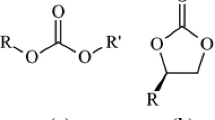Abstract
The catalytic decarbonylation reaction mechanisms of 2-methyl-2-propenal in the presence of hydrogen chloride (HCl), water (H2O), or sulfuric acid (H2SO4) have been investigated theoretically for the first time. Both concerted and stepwise mechanisms have been considered. Compared with uncatalyzed reaction, the transition state energy is decreased by 90.46, 26.35, or 146.74 kJ/mol when the reaction is carried out with HCl, H2O, or H2SO4 as a catalyst, respectively. Our calculations demonstrate that the presence of HCl can reduce the transition state energy dramatically and make the decarbonylation of 2-methyl-2-propenal to be carried out at much lower temperatures, which is consistent with the experimental result. Moreover, the lowest activation energy assisted by H2SO4 suggests that H2SO4 may have better catalytic ability than that of HCl for the decarbonylation of 2-methyl-2-propenal, and our calculational results may be useful for future experimental studies on the title reaction.




Similar content being viewed by others
References
Klein R, Scheer MD, Schoen LJ (1956). J. Am. Chem. Soc. 78:50–52
Schecker HG, Jost W (1969). Ber. Bunsenges. Phys. Chem. 73:521–526
Chen CJ, McKenney DJ (1972). Can. J. Chem. 50:992–998
Freeman JR, Danby JC, Hinshelwood CN (1958). Proc. Roy. Soc. London, Ser. A 245:456–469
Ho SK (1963). Proc. Roy. Soc. London, Ser. A 276:278–292
Trenwith AB (1963). J. Chem. Soc.:4426–4443
Dexter RW, Trenwith AB (1964). J. Chem. Soc.:5459–5464
Eusuf M, Laidler KJ (1964). Can. J. Chem. 42:1851–1860
Imai N, Toyama O (1967). Bull. Chem. Soc. Jpn. 40:81–94
Laidler KJ, Lui MTH (1967). Proc. R. Soc. London, Ser. A 297:365–375
Liu MTH (1968). Can. J. Chem. 46:479–490
Bardi I, Márta F (1973). Acta. Phys. Chem. 19:227–244
Bardi I, Márta F (1974). Acta. Phys. Chem. 20:47–65
Knewstubb PF (1989). J. Chem. Soc. Faraday Trans. 2(85):671–679
Szabó ZG, Márta F (1961). J. Am. Chem. Soc. 83:768–773
Volman DH, Brinton RK (1954). J. Chem. Phys. 22:929–939
Laidler KJ, Eusuf M (1965). Can. J. Chem. 43:268–277
Vasiliou A, Kim J, Ormond T, Piech K, Urness K, Scheer A, Robichaud D, Mukarakate C, Nimlos M, Daily J, Guan Q, Carstensen H, Ellison G (2013). J. Chem. Phys. 139:104310–114311
Rosado-Reyes CM, Tsang W (2014). Int. J. Chem. Kinet. 46:285–293
Smith RE, Hinshelwood CN (1940). Proc. Roy. Soc. London, Ser. A 175:131–142
Smith RE, Hinshelwood CN (1942). Proc. Roy. Soc. London, Ser A 180:253–256
Ingold KU, Lossing FP (1953). Can. J. Chem. 31:30–41
Smith RE (1940). Trans. Faraday. Soc. 2 36:983–987
Grela MA, Colussi AJ (1986). J. Phys. Chem. 90:434–437
Crawford RJ, Lutener S, Tokunaga H (1977). Can. J. Chem. 55:3951–3954
Chabán OY, Domínguez RM, Herize A, Tosta M, Cuenca A, Chuchani G (2007). J. Phys. Org. Chem. 20:307–312
Ruiz P, Castro M, Lopez S, Zapata Á, Quijano J, Notario R (2016). Struct. Chem. 27:1373–1381
Julioa LL, Lezamaa J, Maldonadoa A, Moraa JR, Chuchania G (2014). J. Phys. Org. Chem. 27:450–455
Julioa LL, Moraa JR, Maldonadoa A, Chuchania G (2015). J. Phys. Org. Chem. 28:261–265
Erastova V, Rodríguez-Otero J, Cabaleiro-Lago EM, Peña-Gallego Á (2011). J. Mol. Model. 17:21–26
Teixeira-Dias JJC, Furlani TR, Shores KS, Garvey JF (2003). Phys. Chem. Chem. Phys. 5:5063–5069
Takahashi K, Kramer ZC, Vaida V, Skodje RT (2007). Phys. Chem. Chem. Phys. 9:3864–3871
Buszek RJ, Francisco JS (2009). J. Phys. Chem. A 113:5333–5337
Tavakol H (2011). Struct. Chem. 22:1165–1177
Valadbeigi Y, Farrokhpour H (2015). Struct. Chem. 26:539–545
Buszek RJ, Sinha A, Francisco JS (2011). J. Am. Chem. Soc. 133:2013–2015
Torrent-Sucarrat M, Francisco JS, Anglada JM (2012). J. Am. Chem. Soc. 134:20632–20644
Elm J, Bilde M, Mikkelsen KV (2013). J. Phys. Chem. A 117:6695–6701
Zhang WC, Du BN, Qin ZL (2014). J. Phys. Chem. A 118:4797–4807
Karton A (2014). Chem. Phys. Lett. 592:330–333
Sarrami F, Mackenzie-Rae FA, Karton A (2018). Int. J. Quantum Chem. 118:25599–25608
Gonzalez C, Schlegel HB (1989). J. Chem. Phys. 90:2154–2161
Gonzalez C, Schlegel HB (1990). J. Phys. Chem. 94:5523–5527
Pople JA, Head-Gordon M, Raghavachari K (1987). J. Chem. Phys. 87:5968–5975
Merrick JP, Moran D, Radom L (2007). J. Phys. Chem. A 111:11683–11700
Lee TJ, Taylor PR (1989). Int. J. Quant. Chem. Symp. 23:199–207
Rienstra-Kiracofe JC, Allen WD, Schaefer III HF (2000). J. Phys. Chem. A 104:9823–9840
Frisch MJ, Trucks GW, Schlegel HB, Scuseria GE, Robb MA, Cheeseman JR, Scalmani G, Barone V, Mennucci B, Petersson GA, Nakatsuji H, Caricato M, Li X, Hratchian HP, Izmaylov AF, Bloino J, Zheng G, Sonnenberg JL, Hada M, Ehara M, Toyota K, Fukuda R, Hasegawa J, Ishida M, Nakajima T, Honda Y, Kitao O, Nakai H, Vreven T, Montgomery Jr JA, Peralta JE, Ogliaro F, Bearpark M, Heyd JJ, Brothers E, Kudin KN, Staroverov VN, Kobayashi R, Normand J, Raghavachari K, Rendell A, Burant JC, Iyengar SS, Tomasi J, Cossi M, Rega N, Millam JM, Klene M, Knox JE, Cross JB, Bakken V, Adamo C, Jaramillo J, Gomperts R, Stratmann RE, Yazyev O, Austin AJ, Cammi R, Pomelli C, Ochterski JW, Martin RL, Morokuma K, Zakrzewski VG, Voth GA, Salvador P, Dannenberg JJ, Dapprich S, Daniels AD, Farkas O, Foresman JB, Ortiz JV, Cioslowski J, Fox DJ (2010) Gaussian 09, revision C.01. Gaussian Inc., Wallingford
Luchinskii GP (1956). Zh. Fiz. Khim. 30:96–97
Myers RT (1983). J. Chem. Educ. 60:1017–1018
Funding
This work is jointly supported by the Natural Science Foundation of the Jiangsu Higher Education Institutions of China (contract grant number 10KJB150017), Doctoral Scientific Research Foundation of Jiangsu Normal University (contract grant number: 13XLR003), and A Project Funded by the Priority Academic Program Development of Jiangsu Higher Education Institutions (PAPD).
Author information
Authors and Affiliations
Corresponding author
Ethics declarations
Conflict of interest
The authors declare that they have no conflict of interest.
Additional information
Publisher’s note
Springer Nature remains neutral with regard to jurisdictional claims in published maps and institutional affiliations.
Electronic supplementary material
ESM 1
(PDF 9533 kb)
Rights and permissions
About this article
Cite this article
Du, B., Zhang, W. The reaction mechanism study on the decarbonylation of 2-methyl-2-propenal assisted by hydrogen chloride, water, or sulfur acid. Struct Chem 30, 2271–2277 (2019). https://doi.org/10.1007/s11224-019-01338-5
Received:
Accepted:
Published:
Issue Date:
DOI: https://doi.org/10.1007/s11224-019-01338-5



